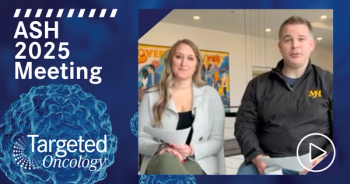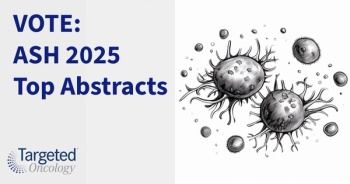
CAR T cells Making a Splash in DLBCL
The high durable response rates seen with CAR T-cell therapies have helped fill a high unmet need for patients with relapsed/refractory diffuse large B-cell lymphoma, with questions remaining on the optimal way to use these agents following the FDA approval of 2 therapies in the past year, explained Anas Younes, MD, during a presentation at the <em>36th Annual </em>CFS.
Anas Younes, MD
The high durable response rates seen with CAR T-cell therapies have helped fill a high unmet need for patients with relapsed/refractory diffuse large B-cell lymphoma (DLBCL), with questions remaining on the optimal way to use these agents following the FDA approval of 2 therapies in the past year.
"The responses with these therapies have been very impressive. We're talking about patients with very bulky disease who have failed multiple lines of therapies who are having major responses, and some of these responses are durable," Anas Younes, MD, chief, Lymphoma Service, Memorial Sloan Kettering Cancer Center in New York, said during a presentation at the36th AnnualCFS®.
Each of the approved CAR T-cell therapies has a slightly different construct, with the main difference seen in the costimulatory domains. Both tisagenlecleucel and the yet-unapproved liso-cel utilize a 4-1BB domain, whereas axi-cel has a CD28 domain. In a panel discussion at CFS®, a panel of experts suggested that the CD28 domain was associated with a quicker onset of adverse events compared with the 4-1BB domain.
"The toxicity happens relatively early, with slight differences from product to product. The CD28-containing CAR T cells seem to work a little faster," said panelists Jae Park, MD, a hematologist-oncologist at Memorial Sloan Kettering Cancer Center. Speaking for all the therapies, Park noted that "most of the toxicity happens within the first 2 weeks. It is rare to see delayed toxicity beyond 2 weeks."
Axi-cel (axicabtagene ciloleucel; Yescarta) was approved in October 2017 for patients with relapsed or refractory non-Hodgkin lymphoma, based on findings from the phase II ZUMA-1 study.1In the study, the best objective response rate (ORR) achieved with the therapy was 82% and the best complete remission (CR) rate was 54%. With a follow-up of 12 months, the durable ORR was 42% and the durable CR rate was 40%.
In May 2018, tisagenlecleucel (Kymriah) was approved for large B-cell lymphoma, based on the phase II JULIET study. In an update from this study presented at the 2018 EHA meeting,2the best ORR was 52% and the best CR rate was 40%. Younes postulated that the durable ORR was likely 34% and the durable CR rate was 29%, although these findings had not yet been confirmed.
Adding to the approved therapies, liso-cel (lisocabtagene maraleucel; JCAR017) has also shown promise in a phase II study, which could lead to a future FDA approval. In the phase II TRANSCEND study,3the best ORR was 80% and the best CR rate was 59% at a liso-cel dose level that is being explored for FDA submission. At 6 months, the ORR was 47% and the CR rate was 41%.
"There are differences between the dosing, the conditioning, and the manufacturing, so they are not all identical. What is interesting, is that the responses are all uniformly high," said Younes. "We cannot compare apples-to-apples because the eligibility criteria were different."
In each of these studies, cytokine release syndrome (CRS) and neurotoxicity (NT), rates varied, although different grading systems were used in each trial. In some cases, the differences in adverse events can be used to tailor therapy. Additionally, payment concerns and manufacturing time could also play a role in deciding which therapy to use, the panelists agreed.
For axi-cel, grade ≥3 CRS occurred in 13% of patients and grade ≥3 NT was seen in 31% of patients. For those treated with tisagenlecleucel, the rates of grade ≥3 CRS and NT were 22% and 12%. For liso-cel, grade ≥3 CRS was experienced by just 1% of patients and 13% had grade ≥3 NT. Across all studies, steroids and IL-6 inhibitors were effectively used to manage these adverse events.
"It is very difficult to compare, because of the differences in patients," said panelist Andre Goy, MD, chairman and director of John Theurer Cancer Center (JTCC) at Hackensack University Medical Center in New Jersey. "If you look at toxicity profiles, there's more earlier toxicity with axi-cel than the other CAR T cells. Early toxicity is also an issue for reimbursement, especially for Medicare."
At this point, CMS has decided to pay a set rate for CAR T-cell infusion, which does not cover the total costs involved in the procedure. CAR T cell infusions require hospitalization and other associated costs, which often bring the grand total for these therapies close to $1 million. Many are looking toward outpatient administration of the CAR T-cell therapies, to help with these cost concerns, the panelists noted. This approach has been successful with the 4-1BB costimulatory-based therapies, the panelists noted.
"We have been trying to go in the outpatient setting, trying to use tisagenlecleucel in this context, because there seems to be less [cytokine release syndrome] in the first 72 hours with this agent," said Goy. "We've done half of patients in this setting, and this seems good for this transition phase."
Now that these agents are approved, the next steps will be to uncover mechanisms of resistance, namely loss of CD19 expression and PD-1/PD-L1 expression. There are several strategies being explored to overcome these mechanisms while improving responses, including CARs with multiple targets, combinations, and earlier lines of therapy.
"CAR T cells are making a big dent in this space but they're not curing everyone, so we need to do more work to find additional treatment strategies for these patients," concluded Younes.
References:
- Neelapu SS, Locke FL, Bartlett NL, et al. Axicabtagene Ciloleucel CAR T-Cell Therapy in Refractory Large B-Cell Lymphoma.N Engl J Med. 2017;377:2531-2544.
- Borchmann P, Tam CS, Jager U, et al. An updated analysis of JULIET, a global pivotal Phase 2 trial of tisagenlecleucel in adult patients with relapsed or refractory (r/r) diffuse large b-cell lymphoma (DLBCL). Presented at: 2018 EHA Congress; June 14-17, 2018; Stockholm, Sweden. Abstract S799.
- Abramson JS, Gordon LI, Palomba ML, et al. Updated safety and long-term clinical outcomes in TRANSCEND NHL 001, pivotal trial of lisocabtagene maraleucel (JCAR017) in R/R aggressive NHL.J Clin Oncol. 2018;36 (suppl; abstr 7505).









































